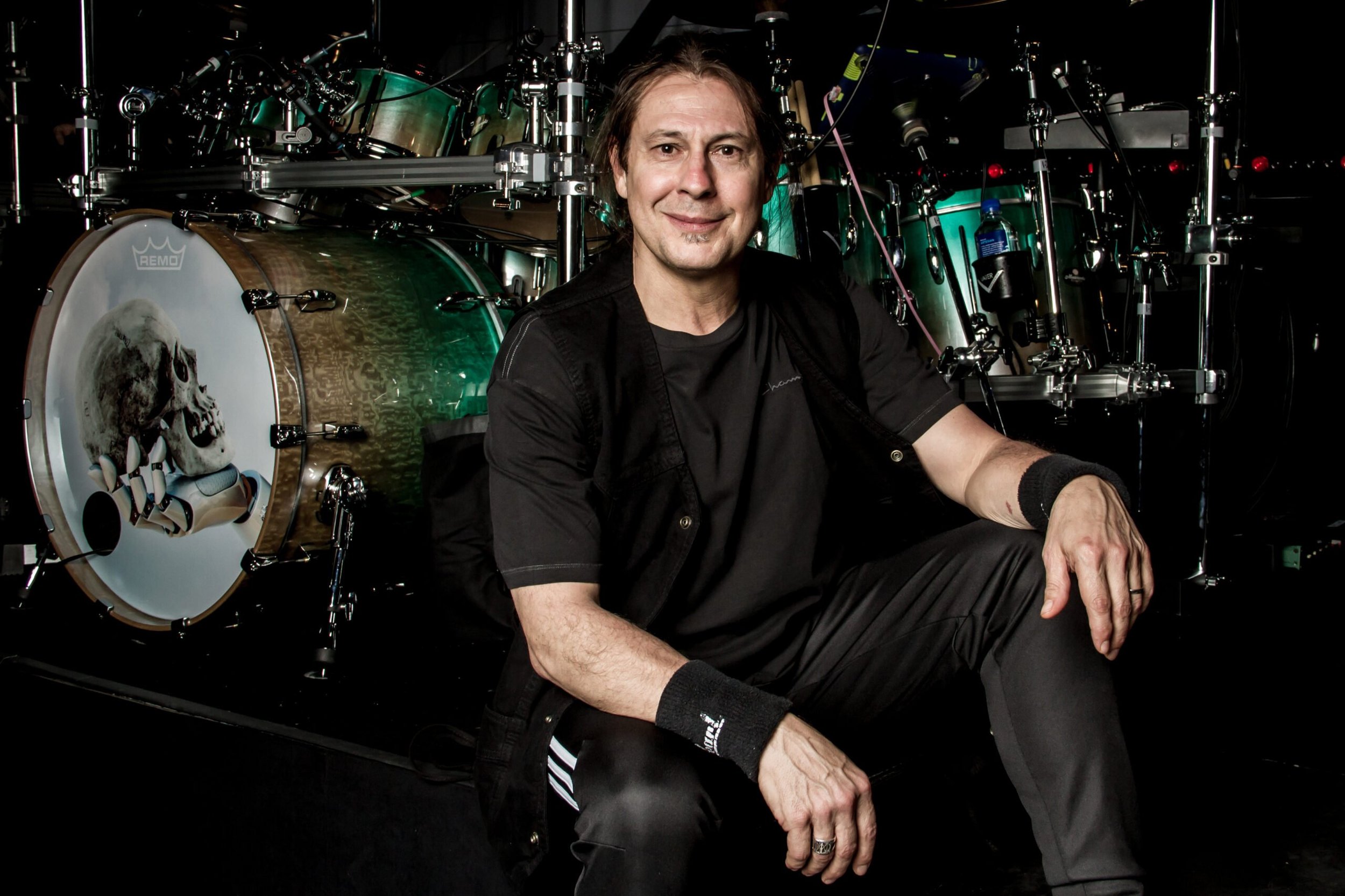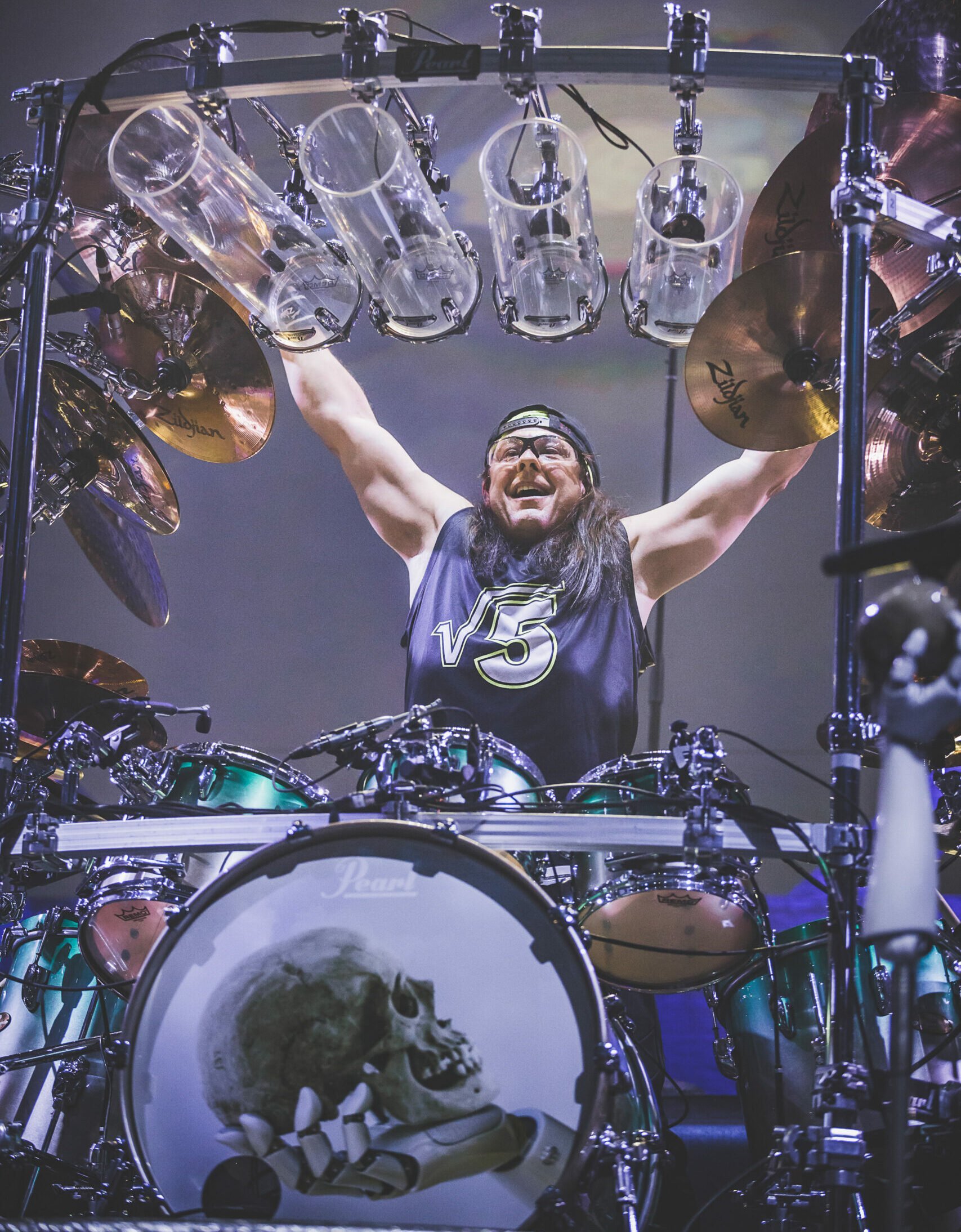
When it comes to performing music, I’ve had serious issues with nerves my whole life.
My body used to get so nervous that my hands would go into fetal position, with my wrists cramped and hands curled in. I had to play a lot of shows with the drumsticks between my index and middle finger.
It’s totally bizarre how nervous and miserable I was. I was scared to play all the time.
Little did I know, this wouldn’t be my biggest problem.
A soul-melting moment happened at a gig in 1987. I was playing with a band called Rick Berlin: The Movie at The Channel in Boston, Massachusetts. I used a click during shows, and this old school drum machine would run a keyboard sequencer among other things.
I looked down at it and had to stop the show. I was panicking and yelling and the band was ready to call the people in the white suits to take me away in a van.
Why? Because I thought something was wrong with the drum machine. It said the tempo was 125 beats per minute, but it felt at least 10% slower, which is a lot. And the drum machine was tied to the sequencer, so I was afraid the music sounded all wrong.
Prior to this band, I was in a Van Halen tribute and used to record the shows. When I’d play back the tapes, I could tell something was off. But I hadn’t been playing live with a click, so I had never noticed it in real-time. At that RBTM gig, when I finally noticed – on stage – that my perceived tempo didn’t even come close to the number on the drum machine…
I knew I had an adrenaline problem.
But I did not know that I had a problem not knowing what to think and when to think it.
I knew I had an adrenaline problem.
That moment in ‘87 taught me something: how horrible of a live drummer I was because I played everything so fast and thought it ruined the songs. It humbled me and also hurt me because I was like, I stink! I literally can’t be counted on because I’m going to play songs too fast and ruin them.
I realized that my perception of reality wasn’t reality. And that’s freaky!
I was dejected. But I discovered that while this was a curse, it was also a gift. I was playing impossible speeds, gig after gig, and my feet were doing things they absolutely had no right to do. It was weird that they could go up to ‘extreme’ speeds on stage, but not off stage. That’s where the gift was. I just had to learn how to understand it so I could harness it.
It’s like time slows down for me. People and time are in a kind of slow motion around me. I can take one second and stretch it out, which gives me more control of where my hits are. I can carve a space up into more slices. I used this adrenaline to increase my ability to play on the grid by expanding it, and these days that’s required in a lot of environments.

Photo: Mark Maryanovich
While learning how to compensate for my adrenaline problem, I began to simulate an almost digital slicing up of time into calculated pieces, offering me more control of it. I would take groupings of all prime numbers – like 19, 17, 13, 11 – and put them inside of a beat. I’d make the drum machine start slow, but then speed up and speed up to increase my ability while not in an adrenalized state.
Why does this work? Because you have to pay attention as opposed to just ‘feeling’ the normal power of two divisions (2, 4, 8, 16, etc.). It helped me learn how to play and recognize these groupings while in a normal state of mind. So when I’d have that adrenaline rush during a show, it would feel slower and therefore more comfortable and controllable.
With a slow click that subdivides less than a drum machine or metronome app typically would, I trained my mind to subdivide on its own from those large, odd prime numbered divisions. Like myself and students of mine, anyone can learn to hear groupings of 19 at extraordinary rates. I think about counting to 10 without quite doubling it, and my body will never be fast enough to have this system fail.
Anyone can learn to hear groupings of 19 at extraordinary rates.
Anybody can practice like this. Slow down the song when you are not adrenalized. Give your mind a chance to examine all the physical motions and how your balance shifts, how you move your eyes and the way you turn your head – all these physical things you wouldn’t normally think of because you’re going too fast at normal tempos.
I also learned how to use audio memory to recognize tempos without a click track. While working through the aforementioned rhythm exercises, I started to memorize songs, their BPMs, and the sound of a click track. When I learn a song at tempo, I make a point to see the BPM number in my mind and really burn it into my memory. When I’m on stage, I can think of the song and get the tempo really close.
Steve Vai could tell this story better than me, but we once had seven months off after a tour and played at the Key Club in Los Angeles in 1998. We used external time for most songs, but that night we had no click, no sequencers and no ADAT. After the show, our manager came to me saying Steve was weirded out because he couldn’t figure out why all his delays were spot on all night with no click. He wanted to know how it was possible. I told her that I was so used to hearing our click that I could literally hear it in my mind during the show.
Developing these skills led to many auditions, and one of them was with Dream Theater. In the three weeks I had to prepare, I was at Berklee during the busiest week of the year, and then I was in South America. I wasn’t able to practice, but I was listening slowly. I mean really slowly. I would air drum through the parts. There was no click to burn into my mind, but by 2010, I knew what to do to burn the songs into memory while away from a drum kit.
When I finally got home to practice, I was able to again slowly digest what I was supposed to learn. And when I got to the audition, my adrenaline kicked in and I knew how to adjust my sense of tempo such that if the song was supposed to be at 162 beats per minute, I was playing at 162 beats per minute. If I didn’t have my previous revelations about using my memory to hear the song at tempo, I would have probably been playing at 170 and ruining the song.

Photo: Nidhal Marzouk
Practicing with a slower click and learning how to fit a disgusting amount of notes inside the beat helped me process time extremely quickly. For example, if Jordan [Rudess] was playing a run, I knew it was 13 and not 12 while it was occurring. He kept stopping and coming over to me and asking me how I could possibly know what he was doing because he was improvising. He didn’t even know!
When I’m playing live Dream Theater shows, I’ve got to play three hours knowing that they write their parts at the top of their game in the studio. If I pump up the tempo too much, the parts would be ridiculously difficult or impossible to play, so my tempo has to be right.
I believe that [John] Petrucci often pushes himself to his maximum chops on every new record knowing that he can trust me to not play a song or part too fast for him to pull off his incredible moves night after night. All the guys push, but I’m singling him out due to the nature of his being the soloist he is. He has a billion cell phones practically shoved up his nostrils at close proximity on a nightly basis. With the tempos nailed and consistent, he can count on me. Literally.
They all can. I feel the confidence in them when we play. It’s really cool. It’s like an unspoken language with serious trust.
Learning how to slow down time and subdivide it comes in handy in my everyday life. I used it playing darts the other day. I slow down the motion of my arms in my mind. But I have to speak to myself and hear my own voice saying things like, “bend arm, slow down, release.” I try to understand the mechanics of how to throw more accurately, whether it’s darts, a football, or a bowling ball.
Zeno, the old Greek philosopher, watched an arrow fly through the air and asked, at any given point in time, where is that arrow? Can I take time and slice it into pieces? This is what gravitated me to calculus and math. This is describing my reality: taking time and slicing it up into all kinds of even and odd tuplets and groupings that help me play better in time. If I was hired to play groovy music that breathed more, trust me, I’d be just as happy using simpler divisions, but that’s not what I’m hired to do.
These days, instead of letting my nerves get to me, that adrenaline rush gets me amped up and positive. If I didn’t allow myself to be humiliated, if I didn’t allow it to humble me in a way and admit that I’m flawed, I never would have found the beauty in it. I never would have seen it as a gift – I would have seen it as a curse my whole life.




By signing up you’ll also receive our ongoing free lessons and special offers. Don’t worry, we value your privacy and you can unsubscribe at any time.
We use cookies for traffic data and advertising. Cookie Policy »